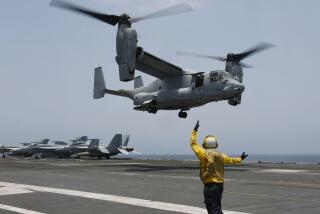Once-Feared Super Stallion Copters Riding High Once More
- Share via
Two years ago, after a string of fatal CH-53E Super Stallion helicopter accidents, residents around the Tustin Marine Corps Air Station began questioning the safety of the large helicopter that flew over their homes.
The residents of Tustin and neighboring Irvine had cause to worry. The helicopter had been involved in eight accidents that killed 24 Marines and injured another 17, many of them stationed at the Orange County Marine base. Once, one of the big $18-million copters was forced to make an emergency landing in a field in Irvine after suffering transmission problems.
City officials in both Tustin and Irvine wrote letters to the Marines expressing their concern, and the Tustin City Council tried to get the military to discontinue helicopter flights over the city until the Super Stallion could be proven safe. “We don’t believe we necessarily have to wait for a major disaster to act,” said Donald Saltarelli, then mayor of Tustin.
The last crash of a Marine Super Stallion based at Tustin occurred Jan. 8, 1987, near the Salton Sea in Imperial County. The aircraft was making a nighttime landing when the pilot lost his “situational awareness” in the dust and sand that was being churned up by the helicopter’s giant rotor blades. The Super Stallion exploded, and all five Marines aboard were killed.
(A Navy version of the CH-53E called a Sea Dragon crashed last July into the Pacific off San Francisco. All eight crew members were killed.)
More than 28 months have passed since the last Marine Super Stallion crashed anywhere in the world. Concerns over whether one of the 100-foot-long helicopters, designed to lift 16 tons or carry about 50 combat-equipped troops, will fall from the sky seem to have dwindled. Super Stallions based at Tustin Marine Corps Air Station are flying more hours now than ever before.
“I think the aircraft got a bad reputation early on, some of it was warranted,” said Maj. Gen. Donald E. P. Miller, commander of the 3rd Marine Aircraft Wing at El Toro and Tustin air stations.
Miller called the Super Stallion the Cadillac of helicopters, a blend of power and sophisticated electronic equipment. It is manufactured by Sikorsky, a subsidiary of United Technologies.
Miller said he believes that pilots have learned more about the aircraft, its limits and mechanics, and have learned how to better maintain the helicopter, which has more moving parts than any other aircraft.
Lt. Col. John Clinton, commander of a Super Stallion squadron at Tustin, said that trying to come up with an answer to why the helicopter had a string of crashes earlier and none for the last 2 years is “like trying to nail Jello to the wall.”
“Maybe you could say some pilots tried to push it (the craft) a little too much,” said Clinton, who was given the task of piloting a Super Stallion with then Secretary of the Navy James H. Webb Jr. aboard when Webb came to California in 1987 to show his support for the troubled helicopter.
Clinton contends that the Super Stallion has a good safety record, even though it had a string of crashes earlier. Of the eight accidents, he said, four were attributed to pilot error and four were because of malfunctions.
The Super Stallion has an accident rate of 7.53 serious crashes per 100,000 hours flown, Clinton said, while the popular Huey helicopter during a comparable 6-year period beginning in 1964 had a noncombat rate of 25.58 accidents per 100,000 hours flown.
“The Echo (Super Stallion) got a lot of bad press,” Clinton said. “We think the aircraft is safe, and if it wasn’t safe, we would not be flying it.”
He noted that the military operates in a “lot more dangerous environment” than most civilian aircraft. Marine helicopter pilots train at night and fly low and fast.
Through use of the Super Stallion, Miller said, the Marines have learned more about how best to move heavy objects by air. The helicopter is capable of lifting 16 tons, more than any other such aircraft outside the Soviet Union.
One of the more serious accidents involved a Super Stallion that was lifting a truck from the deck of a ship off San Clemente Island. The aircraft began bouncing, broke apart and plunged into the sea, killing all four Marines aboard.
Miller said the accident was triggered when a sling apparatus gave way and recoiled back up into the helicopter. So a crew and a helicopter were lost, not because of the craft, but because a lifting device failed.
“When you lift that much weight, things begin to rattle and roll, and you get some strange, creaking noises,” Miller said. “We have learned a lot about hooking up heavy loads, and we learned that the aircraft may not do everything it was supposed to do.”
More to Read
Sign up for Essential California
The most important California stories and recommendations in your inbox every morning.
You may occasionally receive promotional content from the Los Angeles Times.













